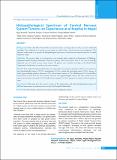Please use this identifier to cite or link to this item:
https://hdl.handle.net/20.500.14356/1266Full metadata record
| DC Field | Value | Language |
|---|---|---|
| dc.contributor.author | Shrestha, Agya | - |
| dc.contributor.author | Parajuli, Sharmila | - |
| dc.contributor.author | Shrestha, Pratyush | - |
| dc.contributor.author | Basnet, Ranga Bahadur | - |
| dc.date.accessioned | 2023-05-04T06:38:45Z | - |
| dc.date.available | 2023-05-04T06:38:45Z | - |
| dc.date.issued | 2020 | - |
| dc.identifier.citation | ShresthaA., ParajuliS., ShresthaP., & BasnetR. B. (2020). Histopathological Spectrum of Central Nervous System Tumors: an Experience at a Hospital in Nepal. Journal of Nepal Health Research Council, 18(2), 219-223. https://doi.org/10.33314/jnhrc.v18i2.1547 | en_US |
| dc.identifier.issn | Print ISSN: 1727-5482; Online ISSN: 1999-6217 | - |
| dc.identifier.uri | http://103.69.126.140:8080/handle/20.500.14356/1266 | - |
| dc.description | Original Article | en_US |
| dc.description.abstract | Abstract Background: More than half of Central Nervous System tumors are benign; however, they can cause substantial morbidity. The classification of central nervous system is vital for their varied outcomes and management. The objective of this study is to provide the histopathological spectrum of central nervous system tumors in a central hospital in Nepal. Methods: The present study is a retrospective cross-sectional study conducted at Department of Pathology, Kathmandu Model Hospital, Kathmandu, Nepal from January 2010 to December 2017 of 162 cases of clinically diagnosed cases of central nervous system tumors. All patients were classified according to the World Health Organization classification of central nervous system tumors. Results: Nine of these162 patients did not have any tumor. The most common categories of tumors were astrocytic and oligodendroglial tumors (39.2%), meningiomas (21.5%), cranial and para spinal tumors (15%), tumors of sellar region including pituitary adenoma (4.5%), and metastatic tumors (3.2%). Glioblastoma(51.6%) and diffuse astrocytoma (21.6%) were the most common astrocytic and oligodendroglial tumors. The most common site of tumors in the brain was frontal (14.37%) followed by temporal (10.45%) region in the brain and dorsal region in spine. Conclusions: This study gives the current scenario of the epidemiology and clinicohistopathological aspects of different brain tumors as encountered in a tertiary level hospital in Kathmandu. Keywords: Astrocytoma; central nervous system; cranial; meningioma; tumors. | en_US |
| dc.language.iso | en | en_US |
| dc.publisher | Nepal Health Research Council | en_US |
| dc.relation.ispartofseries | Apr-June, 2020;1547 | - |
| dc.subject | Astrocytoma | en_US |
| dc.subject | central nervous system | en_US |
| dc.subject | cranial | en_US |
| dc.subject | meningioma | en_US |
| dc.subject | tumors | en_US |
| dc.title | Histopathological Spectrum of Central Nervous System Tumors: an Experience at a Hospital in Nepal | en_US |
| dc.type | Journal Article | en_US |
| local.journal.category | Original Article | - |
| Appears in Collections: | Vol. 18 No. 2 Issue 47 Apr-Jun 2020 | |
Files in This Item:
| File | Description | Size | Format | |
|---|---|---|---|---|
| 1547-Manuscript-17519-1-10-20200911.pdf | Fulltext Download | 358.67 kB | Adobe PDF |  View/Open |
Items in DSpace are protected by copyright, with all rights reserved, unless otherwise indicated.
